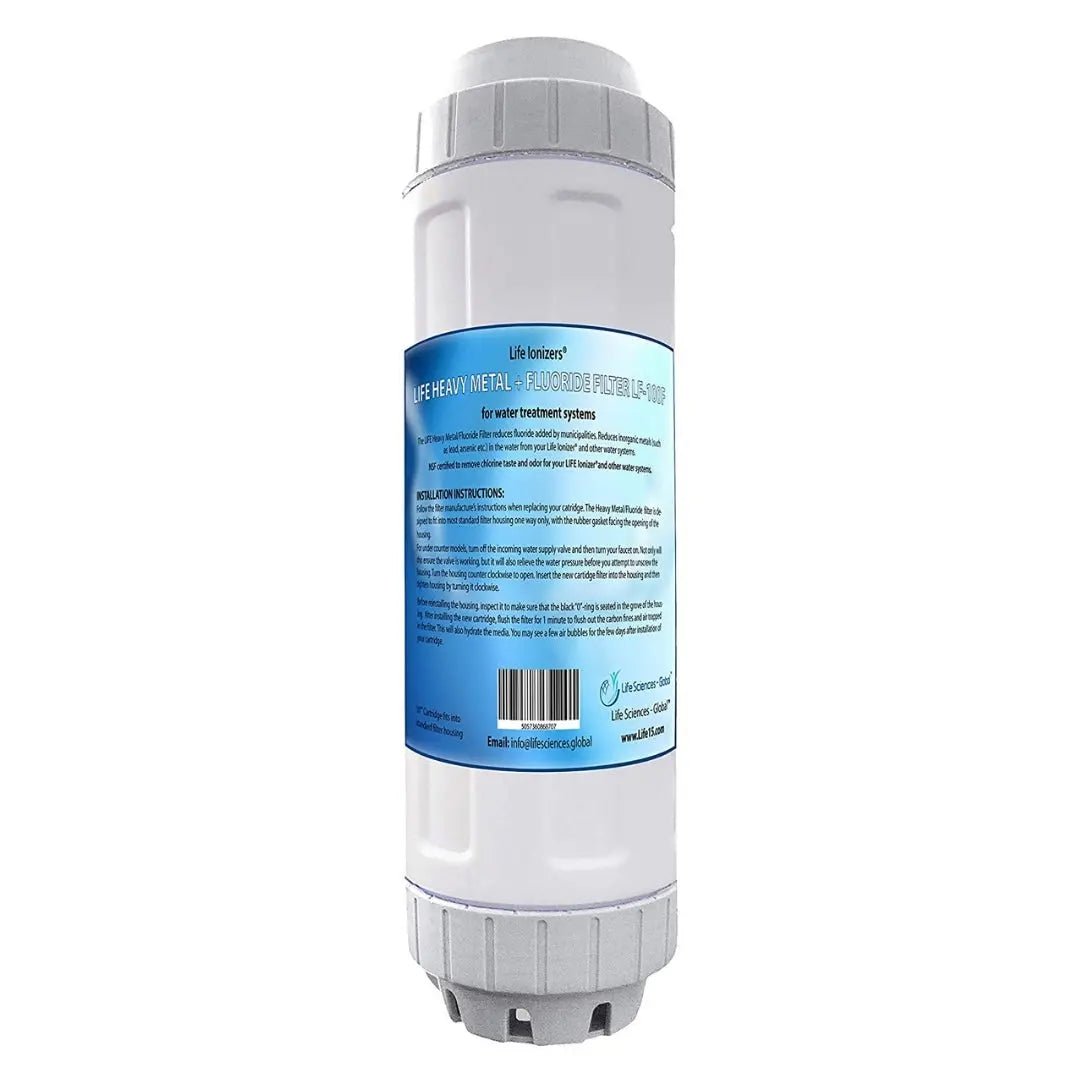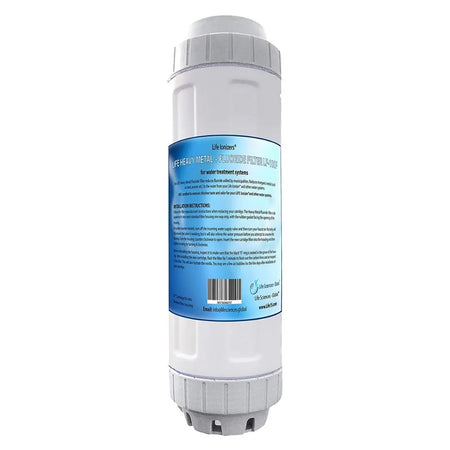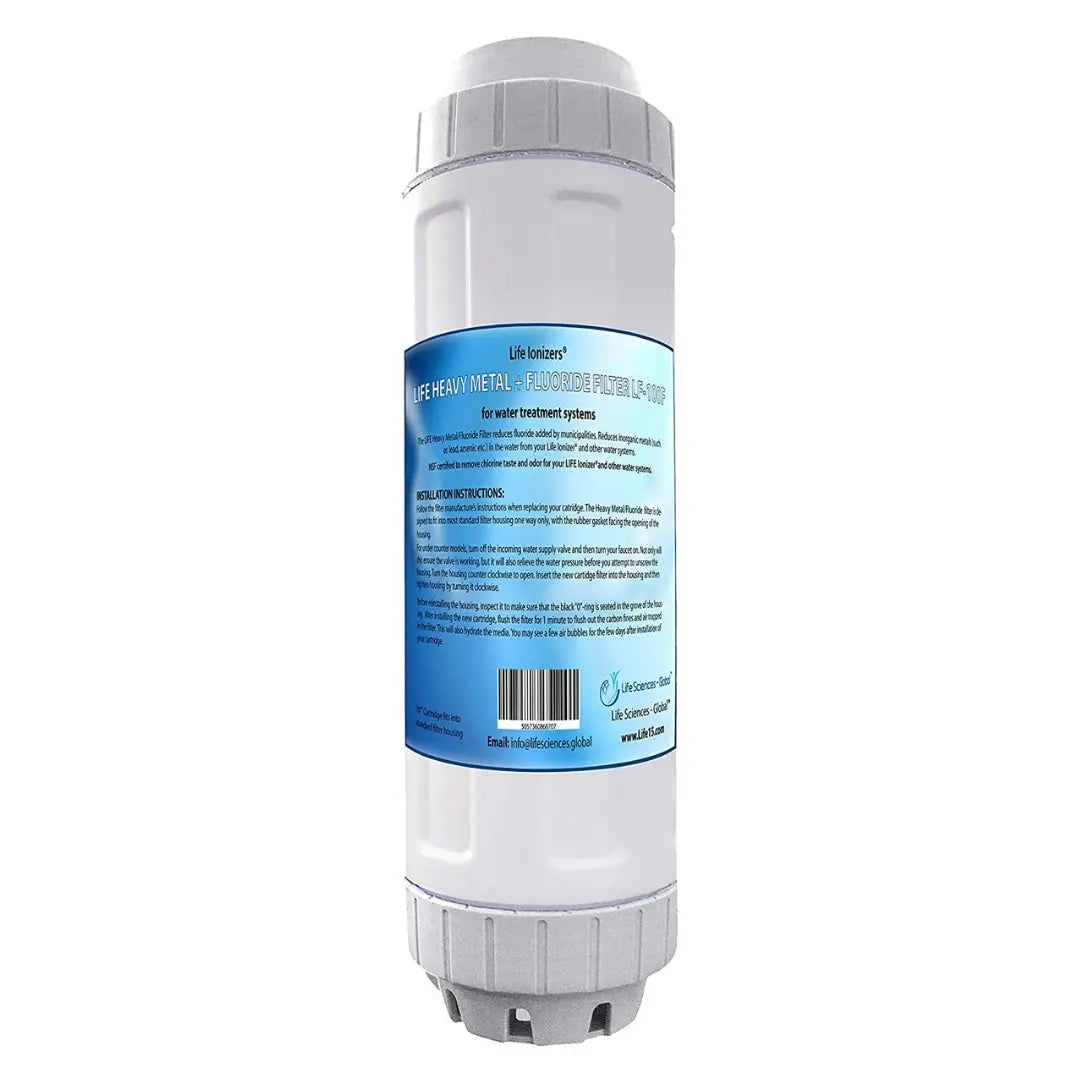Super Filter LF-100F
Couldn't load pickup availability
For full lab results on our Super Filter LF-100F and filter performance, you can view the full independent lab report here.
The LIFE Heavy Metal/Fluoride Filter reduces fluoride added by municipalities. Reduces inorganic metals (such as lead, arsenic, etc.) in your and your Family’s drinking water.
- High-Quality Filter Media – Made by Life with the best filter media available.
- Alumina for Removal of fluoride lead heavy metals uranium arsenate sulfate
- Selenate * many more toxic contaminants
- The Environmental Protection Agency (EPA) has a database of over 86,153 active & inactive toxic chemicals. It only monitors 90 of those and the rest are “No Legal Limit”. So when they say your water is safe. REMEMBER that they told the people in East Palestine, Ohio that their water was safe to drink 3 days after the tragic chemical spill!
- You are responsible for your Family’s health, so filter their water! We also have whole home systems – Click here for more info
We recommend you change HOUSINGS every 3 to 5 years as they become brittle from all the chemicals being filtered out of your drinking water
What does alumina remove from water?
Alumina is a form of aluminum oxide and is commonly used as a filtering agent for water treatment. When used as a filter medium, alumina can remove various impurities from water, including:
Heavy metals: Alumina can remove heavy metals such as lead, mercury, and arsenic from water by adsorbing them onto its surface.
Fluoride: Alumina can also remove fluoride from water through a process called ion exchange. This is important because high levels of fluoride in drinking water can be harmful to human health.
Organic matter: Alumina can remove organic matter from water, by trapping them within its porous structure.
Suspended solids: Alumina can also remove suspended solids from water, such as sediment and dirt, by physically trapping them within its pores. Overall, alumina is an effective filtering agent for water treatment and can help improve the quality of drinking water by removing a variety of impurities.
What is the use of alumina in water treatment?
Alumina, which is a form of aluminum oxide, is commonly used in water treatment for various purposes. Here are some of the main uses of alumina in water treatment:
Filtration: Alumina can be used as a filter medium to remove impurities from water. As water passes through a bed of alumina, it captures suspended solids, organic matter, and heavy metals, leaving the water clean and safe for drinking.
Coagulation: Alumina can also be used as a coagulant in water treatment. When added to water, alumina particles attract and bind together impurities such as sediment. The resulting clumps can then be easily removed from the water through sedimentation or filtration.
pH adjustment: Alumina can be used to adjust the pH of water, making it more alkaline. This is important because acidic water can cause corrosion in pipes and plumbing fixtures, leading to leaks and other problems.
Adsorption: Alumina can be used to remove specific contaminants from water through adsorption. For example, alumina can adsorb fluoride ions from water, which is important in areas where high levels of fluoride can cause health problems. Overall, alumina is a versatile and effective tool in water treatment, helping to remove impurities and make water safe for human consumption
Does alumina adsorb water?
Alumina itself does not adsorb water to a significant extent because it is hydrophilic, meaning it attracts and binds with water molecules on its surface, rather than adsorbing them into its porous structure. In fact, alumina is often used as a desiccant or drying agent, because of its ability to attract and hold moisture from the air.
However, when alumina is used as a filter medium for water treatment, it can capture and remove waterborne impurities from the water, leaving it clean and safe for drinking. The process of capturing impurities involves the adsorption of contaminants onto the surface of alumina particles or the formation of precipitates on the surface, which can then be removed from the water through sedimentation or filtration. So while alumina itself does not adsorb water, it is an effective adsorbent for other substances in water that may be harmful to human health or make the water unusable.
What type of water pollution can activated alumina remove?
Activated alumina, which is a porous form of aluminum oxide, can be used as an effective filtering agent to remove various types of water pollutants. Here are some of the common types of water pollution that activated alumina can remove:
Fluoride: Activated alumina is widely used to remove fluoride from drinking water. It works by adsorbing fluoride ions onto its surface, thereby reducing their concentration in the water.
Arsenic: Activated alumina can also remove arsenic from water. Similar to fluoride, arsenic ions are adsorbed onto the surface of the alumina.
Heavy metals: Activated alumina can remove various heavy metals such as lead, copper, and chromium from water. These metals are adsorbed onto the surface of the alumina.
Volatile organic compounds (VOCs): Activated alumina can remove some volatile organic compounds such as benzene and toluene from water. These compounds are adsorbed onto the surface of the alumina. Overall, activated alumina is a versatile filtering agent that can remove a wide range of water pollutants. Its effectiveness depends on several factors such as the type and concentration of pollutants, pH and temperature of the water, and the contact time between the water and the alumina.
What does activated alumina absorb?
Activated alumina is a highly porous form of aluminum oxide that can adsorb a wide range of substances. The term "activated" indicates that the alumina has undergone a special treatment to increase its surface area and pore volume, making it an effective adsorbent. Here are some of the substances that activated alumina can adsorb:
Fluoride: Activated alumina is widely used to remove fluoride from drinking water, as it has a high affinity for fluoride ions.
Arsenic: Activated alumina can also adsorb arsenic from water. Arsenic ions are attracted to the surface of the alumina, where they are held in place by chemical bonds.
Heavy metals: Activated alumina can adsorb various heavy metals such as lead, copper, and mercury from water.
Volatile organic compounds (VOCs): Activated alumina can adsorb some volatile organic compounds such as benzene and toluene from air and water.
Moisture: Activated alumina is also used as a desiccant to adsorb moisture from the air. Its high surface area and pore volume make it an effective drying agent.
Activated alumina can also be used to adsorb other substances such as hydrogen sulfide, sulfur dioxide, and carbon dioxide. Its effectiveness as an adsorbent depends on factors such as the type and concentration of the substance, pH and temperature of the water or air, and the contact time between the substance and the alumina.
Does activated alumina remove fluoride from water?
Yes, activated alumina is an effective adsorbent for removing fluoride from water. Fluoride is a naturally occurring mineral that can be beneficial in small doses for dental health, but excessive exposure can cause health problems such as dental fluorosis, skeletal fluorosis, and other health issues.
Activated alumina works by adsorbing fluoride ions onto its surface. As water flows through a bed of activated alumina, fluoride ions in the water are attracted to the surface of the alumina particles, where they are held in place by chemical bonds. The treated water that passes through the activated alumina bed is significantly reduced in fluoride concentration, making it safer for drinking and other uses.
Activated alumina is widely used in both municipal and household water treatment systems to remove fluoride, as well as other contaminants such as arsenic and heavy metals. However, the effectiveness of activated alumina for fluoride removal can be influenced by factors such as the pH of the water, contact time between the water and the alumina, and the concentration of other competing anions in the water.
Does activated alumina remove arsenic?
Yes, activated alumina is an effective adsorbent for removing arsenic from water. Arsenic is a toxic metalloid that can occur naturally in groundwater in some regions and can pose serious health risks if ingested over time.
Activated alumina works by adsorbing arsenic onto its surface, where it forms strong chemical bonds. As water flows through a bed of activated alumina, arsenic ions in the water are attracted to the surface of the alumina particles, where they are held in place by these chemical bonds. The treated water that passes through the activated alumina bed has a significantly reduced concentration of arsenic, making it safer for drinking and other uses.
Activated alumina is widely used in both municipal and household water treatment systems to remove arsenic, as well as other contaminants such as fluoride and heavy metals. The effectiveness of activated alumina for arsenic removal can be influenced by factors such as the pH of the water, contact time between the water and the alumina, and the concentration of other competing anions in the water.
bone char what does it remove?
In addition to removing radioactive particles, arsenic, heavy metals, and THMs from water, bone charcoal is also effective at removing fluoride.
Is bone char carbon?
Aged bones are used to create BONE CHAR 2060-BC. Mercury, lead, aluminum, manganese, and silver as well as non-metals such as flouride and bromine can be absorbed by their surface area and base material.
How does bone char remove fluoride?
The hydroxyapatite groups in bone char are effective at removing fluoride impurities by ion exchange and electrostatic interaction. For example, cattle bone char can adsorb 11 mg/g of fluoride at pH 3 in the presence of 20 mg/L fluoride impurities.
Is water filtered through bone char?
Water can be treated with bone char to remove heavy metals, chlorine, fluoride, and other contaminants. In addition to being used in sugar refining, it is also used as a black pigment. The majority of it is made from cow bones. It is produced similarly to biochar, but only contains 10% carbohydrates
How does bone char filtration work?
A carbon structure supports a porous hydroxyapatite matrix (calcium phosphate hydroxide in crystalline form, which is rich in surface ions that can be readily replaced by fluoride ions). Bone char reduces fluoride through adsorption and ion exchange.
How does bone char remove fluoride?
Share By ion exchange and electrostatic interaction, hydroxyapatite groups in bone char are effective in removing fluoride impurities. Bone char from cattle, for instance, can adsorb 11 mg/g of fluoride at pH 3 when 20 mg/L of fluoride impurities are present about your brand with your customers. Describe a product, make announcements, or welcome customers to your store.
Does bone char remove chlorine?
Using bone char carbon, you can reduce or remove fluoride, arsenic, radioactive isotopes, iron, lead, mercury, aluminum, silver, bromine, manganese, and more. Furthermore, it removes chemicals, tastes & odors, chlorine, chloramine, herbicides, pesticides, MTBE, and THM better than standard carbon.
Is bone charcoal the same as activated charcoal?
Bone char differs from activated carbon in that it contains both carbon and hydroxyapatite surfaces. Certified Kosher/ANSI 61.
Does charcoal filter remove calcium?
It is not true that activated carbon filters reduce Total Dissolved Solids (TDS) such as chlorides, sodium, calcium, and sulfates. The use of carbon filters reduces chlorine taste and odor significantly.
What is bone char made of?
Calcium carbonate, calcium phosphate, and calcium acetate are the main components of bone char. Carbonate in the char is replaced with fluoride ions to eliminate fluoride. Based on several investigations, a number of factors affect the uptake capacity of bone char in the removal of fluoride from raw water. When filtering water, charcoal carbon filters are the most effective for removing chlorine, sediment, volatile organic compounds (VOCs), taste, and odor. Salts, minerals, and dissolved organic substances cannot be removed. Ion exchange systems and reverse osmosis systems can be used to eliminate inorganic contaminants in ionic form. The presence of free chlorine in water is another type of inorganic contamination.




